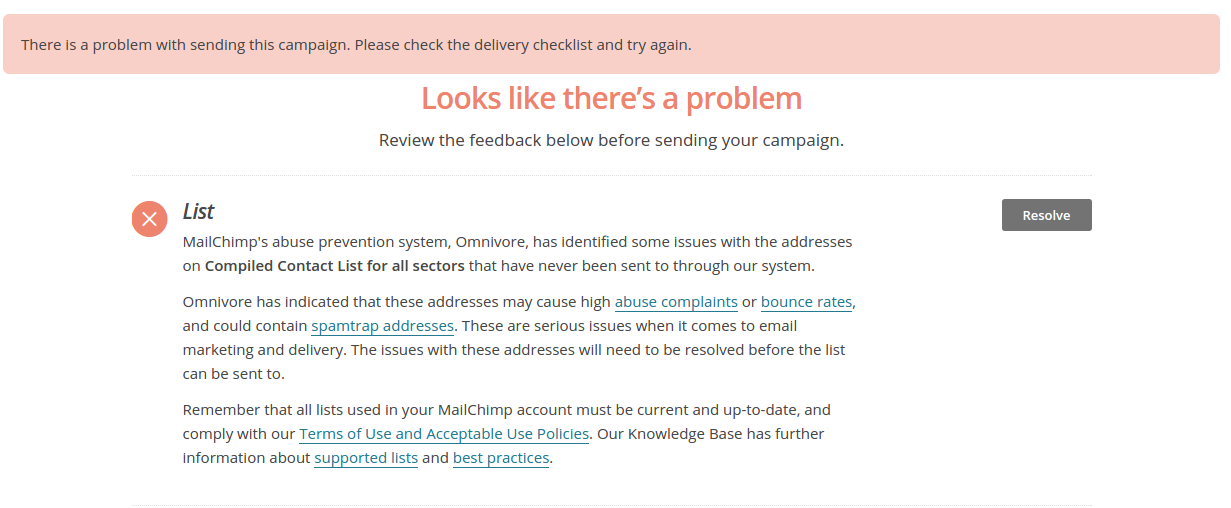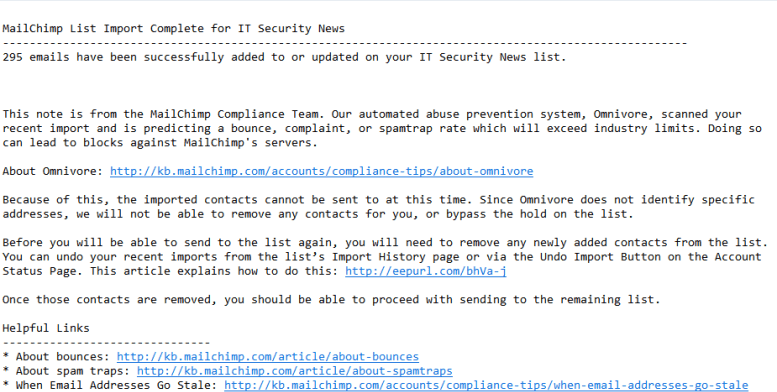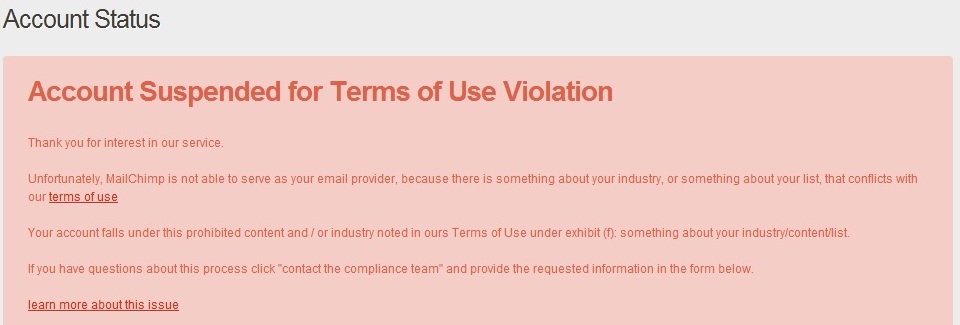If you use MailChimp, then its abuse-prevention program Omnivore may make it more difficult to get 100% email deliverability on your email campaign.

Does this look familiar? It’s an Omnivore warning.
MailChimp uses Omnivore to reduce suspicious activity stemming from malicious email addresses, bad URLs, and questionable keywords. And while Omnivore is necessary it can make marketing campaigns a bit of a chore if the rules are not followed.
This post explains in detail how Omnivore works, types of Omnivore warnings and what to do if you receive one. We’ve also included a guide to verify your email list and prevent future Omnivore warnings.
What is Omnivore?
Think of Omnivore like MailChimp’s filter. It uses an artificial intelligence (AI) system that automatically scans every email list you upload to the MailChimp system.
Omnivore looks for email addresses that might trigger complaints, high bounce rates, or blacklisting. If your list has a high percentage of these there is a good chance it will cause an Omnivore warning and you will be forced to address the problem before proceeding.
MailChimp debuted Omnivore in 2008 and fine-tunes the algorithm regularly based on feedback and AI.
How does Omnivore work?
Omnivore’s algorithm assigns a level of risk to each email list that you import. If the risk level is deemed high enough, MailChimp will not deliver to those addresses. And purposely, it will not tell you which addresses it views as high-risk — so it is on you to diagnose which ones are the problem, and fix it.
Why is MailChimp Omnivore necessary?
MailChimp doesn’t run Omnivore to be sinister or annoying. They want to protect their reputation — as well as yours! You see, getting the reputation of being a spammer can cause major problems for both of you. Email systems can be blocked by Internet Service Providers (ISP) for sending to much spam.
What is an Omnivore warning?
An Omnivore warning is a message MailChimp sends to users when an email list is not clean enough. MailChimp won’t send your email campaign to the list until you improve the data to meet Omnivore’s standards.
Here’s what an Omnivore warning looks like ↓

Warnings can be seen via email (as seen in the image above) or within the MailChimp SaaS. Once you receive a warning you’ll have to take action.
One simple way to overcome an omnivore warning is by using an email verification system like [Bounceless.io] that helps you detect which addresses are likely to bounce back and generate complaints.
What triggers an Omnivore warning?
MailChimp has defined the elements of an email list that will trigger an Omnivore warning, including stale email addresses, unfamiliar email addresses and spam traps.
MailChimp Omnivore looks for stale email addresses
A stale list is a list of addresses that has not received emails from your business in a while. A stale list will have a higher volume of undeliverable results than a list that is regularly targeted by emails.
Why?
Because stale email addresses frequently become inactive — people change roles, leave companies, or may reject your emails as no longer relevant to them.
Databases decay at a rate of around 23% percent a year as contacts move on from jobs or change email addresses. Keeping your data up to date is hard work. And that’s work MailChimp expects you to put in.
MailChimp Omnivore looks for unfamiliar email addresses
Each time you import new email addresses into MailChimp, Omnivore checks your list for addresses you haven’t contacted before through the MailChimp system.
Unfamiliar email addresses can come from a variety of places. They could be recent imports, people who signed up through a form or mobile application, or individuals that you have sectioned from earlier email campaign sends.
If you exceed the threshold of unfamiliar email addresses, you will receive an Omnivore warning.
MailChimp Omnivore looks for spam traps
Omnivore scans new lists for spam trap email addresses. A spam trap is an email address used by ISPs, anti-spam organizations and third parties to identify out-of-date lists or generate abuse complaints. Often these spam trap email addresses do not necessarily belong to opted-in subscribers, and are sometimes used solely to catch spammers.
It’s best to heed to these warnings to prevent your emails from being blocked.
The difference between an Omnivore warning and account suspension

In addition to a warning, MailChimp user accounts can also get suspended. Suspensions come about due to one of of the following reasons:
- Issues with recent email campaigns
- The list collection process is unclear
- You signed up with a free email account
- Recent email campaign activity violates Terms of Use
If you are suspended MailChimp customer support will contact you and try to resolve the issue. If any MailChimp user is suspended three times in 6 months Omnivore will permanently shut down the account.
So heed our advice: take Omnivore warnings seriously!
What to do when you receive an Omnivore warning
Don’t ignore the warning! It won’t just go away and you won’t be able to resume your email campaign until it’s addressed.
Clean your email list & re-import it
So if you have recently imported a list into MailChimp that Omnivore has flagged you will need to remove the import and clean the list for bad addresses. While you are cleaning this list, the rest of the lists on your MailChimp account remain unaffected and usable.
MailChimp is known for its diligence with regards to protecting its customers. It has a great reputation for delivering effective email campaigns that reach their intended destinations. After all, no one likes receiving spam and MailChimp goes to great lengths to make sure that people don’t.
How to prevent Omnivore warnings
There are ways to ensure you that you are uploading clean lists and getting as close to 100% email deliverability as possible. Just follow these tips.
Get double opt-ins
When someone signs up to receive an email from your organization, they should go through a double-opt in process. This means that when someone signs up to receive emails from you, a verification email is sent immediately to the email address they provided. The opt-in process is not complete until they have clicked on the verification link.
Following this double opt-in process is the only foolproof way to have a truly ‘clean’ subscriber list and to be sure that every recipient has explicitly agreed to receive your campaigns.
Check for role-based emails
This is another important way to avoid Omnivore warnings, because MailChimp views role-based emails as a tell-tale sign of an unclean list.
Role-based emails are any generic, non-named address such as info@riw.com or admin@play.com. They have an extremely high bounce rate and Omnivore has a low threshold for how many are allowed. Role-based addresses are often the reason you will receive an Omnivore warning.
Be careful with third-part lists
Omnivore is precise in verifying high risk, stale and spam email addresses. Sometimes lists bought or leased from third parties will contain very old email addresses or email addresses that Omnivore identifies as spam. Third parties are known for using questionable data collection tactics that result in a high number
Acquiring emails yourself is the only way to control and ensure that you have a quality list that will pass Omnivore. Omnivore is especially tough on cold lists. Most of the time they will be rejected.
How to verify your email list and prevent Omnivore warnings
Get as many double opt-ins as possible
As a business owner or marketing manager, it is best practice to require users to double opt-in. For those that don’t know, double opt-in means that the subscriber clicked two times that they wanted to be added to the list. Typically once on your page and then again when they open your confirmation email.
This will cut down on spam and reduce the number of people who may have inadvertently signed up to receive information from you.
This is also better for MailChimp as the email addresses will include real names instead of role-based titles like we previously mentioned that Omnivore sees as high risk due to their rapid turnover rate.
Ultimately, using a double opt-in process to collect email addresses will deliver cost savings and help build strong, clean email lists.
Use a cloud-based service to help clean your emails
No matter the size of your list, a cloud-based service can validate it. By validate we mean check that your addresses properly formatted, and whether its mailbox exists and can accept new email messages.
Just go online and do a quick search for “email address validation.” There are plenty of companies that verify email address lists for very competitive rates.
What to look for in an email validation service
You also want to make sure that the email verification company doesn’t delete any addresses, but agrees to return your list intact with added information stating which ones are good, which are bad and which are unidentified. This is an especially important practice if you have an old outdated list.
A cloud-based service is ideal if you are looking for precision because they ensure that the email addresses will be completely validated.
Fancy doing some of it on your own?
You can do some of the legwork by yourself. Start by opening your list in Excel and organizing it by title. Then you can quickly notice and delete any role-based emails, free email addresses, or old email addresses (especially those who have not been sent a message in a long time).
Also look for any duplicates and addresses missing the “@“ symbol.
Email list scenarios you may have encountered
New addresses recently uploaded to list
You recently uploaded a new subscriber list and didn’t have any initial compliance issues. It worked and you think you are in the clear. But then Omnivore runs its algorithm and discovers that some of the added addresses are invalid Now your list is invalid.
At that point you will have to clean your list and resubmit the email addresses with a greater likelihood of 100% email deliverability.
An old list with bad data
Sometimes you may fail to contact your subscribers for a long period of time. As result your list is chalk full of stale and invalid data. It’s an easy problem to solve: just reconfirm the addresses on your list and weed out the bad ones.
Mystery data!
For whatever reason, sometimes accounts are shared and you may not be sure when subscribers were most recently imported. If this is the case, it is strongly recommended that you use segmentation to delete the email addresses believed to be the problem.
Whether your email address list is new or old, it can trigger warnings from MailChimp’s Omnivore.
Spam is growing in sophistication — email validation has to keep up
It takes less than a second to check an address with an email validation system. And that second could be the difference between your list passing and failing Omnivore’s test and getting your campaign delivered.
One option would be to use a service like [Bounceless.io], which checks deliverability and returns a list check rate of at least 95 percent.
Remember, your data is an asset, don’t entrust it to just any service. Make sure that your chosen email verification business is focused on helping you get as close as possible to 100% email deliverability.
The cost of having your email list validated will vary depending on which provider you choose. Typically, there are two different fee structures. Pay as you go; use only what you need. Or a subscription plan that comes with a setup cost.
[Bounceless.io] offers a free service tier. You can check and clean a portion of your list. This allows customers to see what type of reporting is executed and gives a snapshot of the value it provides before you invest in cleaning a full list.
What NOT to do when you receive an Omnivore warning
Once you’ve received an Omnivore warning it could be tempting try to the problem on your own by sending a blind-cc (Bcc) to everyone on your list and sending it back to yourself. That way you can see which email addresses bounce back and remove them from your list.
Unfortunately that’s not as good of an idea as it might seem. A mass Bcc like that will affect your reputation with your email service provider and could bring unwanted attention to your your IP address. If you do this a couple times your ability to send emails could be in danger.
What Omnivore doesn’t do
As mentioned earlier, Omnivore is an algorithm. You can also interact with the MailChimp support team if you feel like Omnivore is shutting down innocent, opted-in users. If your account is flagged or suspended, it will be reviewed by their team. If you’re curious about how the MailChimp abuse team makes its decisions, here are a few compliance tips.
Do you need any help?
Email campaigns can be crucial to company strategy and bottom lines. Getting your message into your subscribers inbox successfully, and with out Omnivore’s annoying interference, is paramount.
Reach out to [Bounceless.io] if you need a hand.



